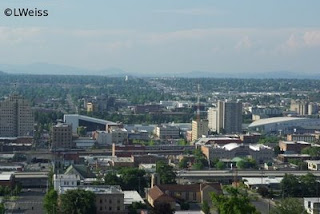Progress
 There's a sign at the airport in Spokane, WA that welcomes travelers to the "Inland Northwest." Spokane must be the heart of this country as it's by far the largest city in the region. It's a major stopping point for today's travelers along I-90 and a fascinating focus point for a great deal of the area history.
There's a sign at the airport in Spokane, WA that welcomes travelers to the "Inland Northwest." Spokane must be the heart of this country as it's by far the largest city in the region. It's a major stopping point for today's travelers along I-90 and a fascinating focus point for a great deal of the area history. Spokane seemed the logical waypoint for many of the western railroads on their way from the Midwest to Seattle. Among many other things, Spokane became a cross-roads for these companies. The Northern Pacific, Great Northern, Union Pacific, and SP+S all had a presence here at one time. That doesn't even take into account the various lines that were absorbed into the larger companies (like the interurban 'Spokane and Inland Empire' which became GN or the 'Spokane International' which rolled into the UP). Railroad history is thick here in the heart of the Inland Northwest.
There was a late entry into the city of Spokane as well: America's Resourceful Railroad, The Milwaukee Road. Its original line (and mainline) across the state of Washington bypassed Spokane, choosing to remain south of the city. This brought it through the small towns of Rosalia, Pine City, and along the shores of Rock Lake. While this line remained the mainline for transcon freight operations to the bitter end, early in the life of the Pacific Coast Extension, the Milwaukee realized the need to access Spokane. Trackage rights were worked with Union Pacific to allow access to the bypassed city and Milwaukee yards were located to the east of downtown.
All of this was long, long ago. The yards the Milwaukee plotted are still used by the Union Pacific today, but little is left of the Milwaukee in Spokane itself. The passenger station where the Olympian and Columbian called was removed for the World Exposition of 1974 as was the monster steel trestle that carried the UP/Milwaukee across the Spokane River. The long trench that was dug to accommodate the line out of Spokane to the east of the station has also been slowly filled in. Just recently one of the last remaining sections has been filled as part of a Washington State University campus project. Time has a way of changing things, and Spokane has seen some dramatic changes.
A Birds-eye view of downtown Spokane on a lovely summer evening in 2008 shows the city as it exists today. The UP/Milwaukee route is gone, the Great Northern has been lifted as well. Trains now share the Northern Pacific line through the city and Amtrak's Empire Builder calls at the old NP station - now also the Greyhound station. Few vestiges of the old railroads that joined in Spokane's downtown remain while the city itself continues its drive to renew and reinvent. This view of Spokane can conjure up a host of emotions ranging from the heaviness of history and change to the hope of a city trying to find its new place in the world. Progress is not always beautiful even if hope is.



Comments
It is sure hard to recognize the former MILW yard now that the neighboring UP yard is nearly gone and fully developed.